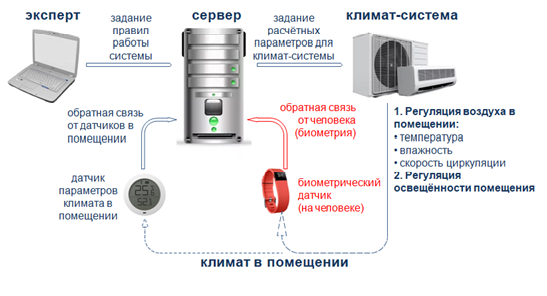Biometric feedback

The article was based on the text of the author’s speech at the DataFest6 Project pitch-session, which was held on May 10-11 in Moscow
We all once were children, many of us already have our own children, or at least have experience with small children. Therefore, we can imagine how a child who cannot speak speaks to adults what is happening to him. First, an adult pays attention to the baby, sees his appearance, complexion, perhaps touches his forehead and, based on the results of such actions, decides what to do to make the child feel good.
')
We formalize the process description:
- remove data
- substitute them into the model (which is in our head),
- according to the results of the simulation we take action
What is important: the child himself does not give orders to anyone, adults only watch the biometric data and as a result the child receives actions that return him to the comfort zone.
This is an illustration of a statement: a person can control machines not only through movements or through thought (through reading of neural impulses), but also by means of bio-parameters. Or it is more landed: the life support system can be built on the basis of a cycle with biometric feedback .
Business application
First, remember what a smart home or smart home. Wikipedia writes that it is an automation system for a residential or commercial building. For example, leaving the house, you close the front door, and at the same time the house turns off electricity, water and an alarm is connected. Now all elements of the Smart Home are working under a hard scenario. That is, in order for the air conditioner included in the Smart House system to stop heating and to cool the air, it must be reprogrammed. If an adult, capable person is involved in reprogramming, then it will simply not be very convenient for him. But let us imagine that we are talking about, for example, small children who play alone in a room, or an incapacitated person who, in principle, is not able to do anything on his own, or simply a sleeping person to whom the same air conditioner directs his flow…
Sometimes the actions of “human helpers” working under a harsh scenario can do more harm than help a person. It is clear that a system that reads the needs of the owner would be much more convenient.
A variant of such a system is shown in the figure. This is a business idea, the material elements of which are already largely developed.

The diagram at the beginning of the chain is an expert. He sets the rules of work, after which the server gives the order to the climate system to start work. The climate system regulates the air humidity, temperature, air flow rate, light intensity. As a result of the operation of this system, the parameters of the home climate change, which affects the person. Further along the chain, the data from the person and from the external environment (both from the house and from the street) go to the server, are processed and the server gives commands based on new data. The cycle is closed.
Sensors on a person provide biometric feedback and allow you to achieve from a climate system such home climate parameters that allow a person to feel comfortable.
Key points of the scheme
The key points of the circuit are the sensors and the control unit .
What sensors are convenient to use for a person? It seems that this role should try to use the modified analogues of fitness bracelets , which are worn on the wrist to measure bio-data during sports.
Now ordinary fitness bracelets are measured (this list is most likely not complete):
- pulse,
- temperature,
- breathing rhythm
- level of perspiration
- blood sugar
- heart rate,
- the proportion of adipose tissue
- arterial pressure,
- blood oxygen saturation
- water balance in the body,
- and know how to send this data via Wi-Fi.
The second key point of the circuit is the control block. The task of managing the system is reduced to modeling the connection of human parameters and environmental parameters. Man, if considered as a generator of biological parameters, is a system that is stable in the range. Resilience is the ability of a system to maintain its current state when exposed to external influences. Each person has his own individual set of combinations of parameters that retain stability in a certain range. Presumably, a set of points either from the parameter space or points of the phase space associated with these parameters (phase trajectory) describes a dynamic state of comfort, its own for each individual person. That is, such a model, by definition, must take into account individual preferences of people.
It seems most appropriate to create a model of communication parameters of a person and the parameters of the external environment using machine learning .
Now the main problems associated with machine learning in the framework of the project are seen:
- how the model will be trained,
- how to reduce training time.
Separate consideration is the search for training options for the model, which will depend, in particular, on the nature of human parameters that have the most serious impact in the context of feedback.
The issue of reducing the training time of the model is most likely solved by using a pre- trained system that will be trained by the user during operation.
Simpler questions, for example, associated with the simultaneous stay of several people in the room (whose preferences to choose) and other questions of the “managerial” level are easily solved by manually setting the system for the user.
Such systems with biometrics can be used widely: they are suitable for many rooms where a person is located for a long time. These are private houses, boarding houses, closed premises, cars, cabins of watercraft.
Commercialization of development
Why is the commercialization of this business idea interesting? There are several interrelated answers to this question.
Now in business literature they write a lot about aspects of digitalization. Old ways to promote products are becoming ineffective and business is looking for new approaches. The world of business is talking about customization - the transition from a group approach to production to the individual. With an individual approach, products are not made “for all” ( fit-for-all ), they are made for each individual person. Customization is economically beneficial for manufacturers, as it provides a competitive advantage by creating higher value for the consumer.
Developing a biometrics feedback system will allow us to customize our living space: an apartment, a house, a car, a water vessel.
An important factor in any development is its degree of readiness and cost . And here the project also looks advantageous: the material components of the presented scheme - the climate system and sensors - do not need to be developed from scratch; in fact, it will be necessary to adapt the existing samples for specific needs. Significant development requires only soft: creating a model on which the system will work.
Let's give an example. I remember a graph from a single study on the main trends in the field of Artificial Intelligence. The graph shows that part of the AI trend is already widely used by the business (High Level of Business Adoption). But attention is attracted by other areas of research, which are less interesting for business and conventionally called Experimental. Looking at these trends, you are surprised to realize that they have long been heard, but business is still not actively using them. From the point of view of the author, this fact clearly shows the importance of choosing a research topic for subsequent business success. It is the right topic that largely ensures a high speed of transition from the “experimental” stage of the project to the “production” one. The choice to develop a topic that is “understandable” to a business and has a high degree of readiness is the key to a high level of attractiveness of research for business.
And finally: when considering the economics of a product, one should understand that the one who develops this project receives not one product, but a ready-made platform for a number of applications.
The author is interested in modeling systems related to man. In particular, it is of interest that with the massive use of systems with biometrics, over time there will be an accumulation of information about the relationship of human bio-data with environmental parameters. Such information will be valuable material for further work.
Source: https://habr.com/ru/post/453810/
All Articles